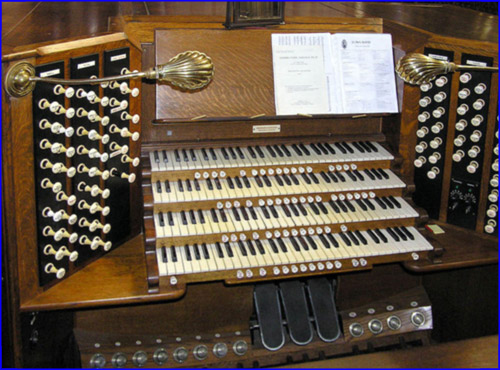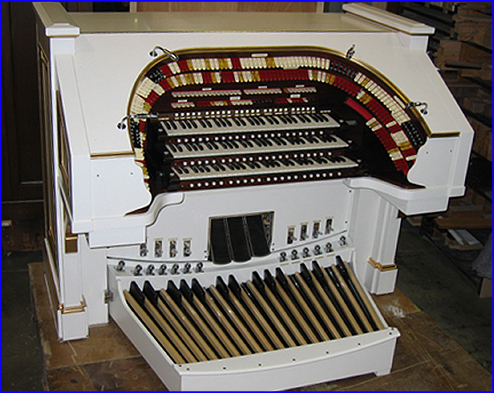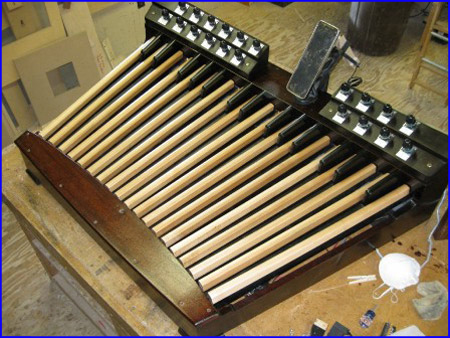The PIPE ORGAN
North Suburban HAMMOND ORGAN Service
General Pipe Organ Info
Here are two pictures of pipe organ consoles. Figure one is that of a large classical or church pipe organ, and figure two is of a theater organ console. These pictures show the two standard types of stop controls that most pipe organ builders use, the draw-knob type and the tab type. The tab type is standard practice on all theater organs and also on many classic or "straight" instruments, but the drawknob type was the original form of stop control and it is still widely used on many classical instruments and concert instruments as well.

Figure 2. A typical classical or concert pipe organ console. The three large pedals at the lower center control the volume of two of the instrument's divisions, and the one farthest to the right is the crescendo pedal. This instrument has numerous toe studs, many of which duplicate the functions of some of the preset buttons below each manual. One of these, most likely to the right of the crescendo pedal is the Sforzando or full organ control.
It is easier to turn stops on and off if they are in the tab form, but most musicians would utilize the preset buttons below each manual to make multiple stop changes and thus it really doesn't make all that much difference in the majority of cases. My personal preference is for tabs, because they are easier to move quickly if, after hitting a combination button, you want to make a few individual stop changes as you are playing.
Figure 3. Console of a large theater pipe organ. This is the typical Horseshoe console style which puts all stop tabs within easy reach of the musician. Although it might not seem so, when it comes to ease of use and comfortable playing, these large pipe organ consoles are much nicer and easier to use than the average tiny spinet electronic.

It appears that there are many more stops on the theater pipe organ console than on the classical organ console, however, there are actually many more ranks of pipes in the classical instrument. We will get into the reason for this difference a little later on. Both of these pictures however represent typical examples of fairly large pipe organs.
Figure three is that of a typical pipe organ 32 note radiating and concave pedalboard. In this picture, which I downloaded from the Internet, the pedalboard appears to be set up on a workbench. But if you are only familiar with electronic organ pedalboards, this picture shows what a typical pipe organ pedalboard looks like. Whether you play classical, beginning pops, or fancy jazz, a pedalboard like this makes pedalling surprisingly easier, and more accurate too.

Figure 4. Typical pipe organ pedalboard set up on a workbench in a shop.
As you can also see from these pictures, pipe organ consoles tend to be quite large, however most consoles that I have encountered are pretty well designed in order to be easily disassembled into manageable sized sub sections which means that it's easy to move such a console, or at least easier than it might appear at first glance.
Previous Page Page 6.
Next page